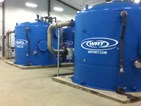Pioneering Uranium Removal Facility Goes Online

By Kevin Westerling, Editor
In an attempt to get ahead of the curve of rising uranium content and government regulations, the City of Grand Island, NE, recently opened a $3-million uranium removal facility, the largest of its kind in the nation. Although the city’s drinking water was within U.S. Environmental Protection Agency (EPA) standards, naturally occurring uranium was steadily increasing, prompting development of the 4,200-square-foot pilot project.
The ion exchange process incorporates a synthetic resin, or treatment media, housed in four, 13,000-gallon water tanks. About 1.5 billion gallons of water will pass through the tanks each year, representing a relatively small portion of the municipality’s source water — three pumps out of 21 — delivered from the Platte River Well Field. The water is then blended together to reduce overall uranium content and stay ahead of the EPA’s maximum contaminant level (MCL).
The current MCL for uranium is 30 parts per billion (ppb), and water coming into the plant, according to Grand Islands Utilities Director Tim Luchsinger, was in the “high 20s.” After undergoing the new treatment process, complements of Water Remediation Technology, LLC (WRT), Luchsinger reported that uranium was reduced to non-detectable levels, or less than 1 ppb. If uranium in the source water continues to increase, or if the EPA decreases the MCL, the system can easily be expanded.
Under the contract terms, WRT will handle operation and maintenance for 10 years at an annual cost of $780,000. Maintenance includes the removal and replacement of spent resin — containing as much as 300 pounds of uranium per year — to a licensed landfill every 12 to 18 months. The uranium-filled resin poses no health risk to workers, even if spilled; rather, it is the chronic and prolonged exposure through ingestion that can be dangerous to the public.
Grand Island secured a municipal water bond and implemented a water meter fee to pay for the project, which will be monitored closely for its long-term effectiveness and value. If successful, it could be a model for many more municipalities dealing with elevated uranium levels.
